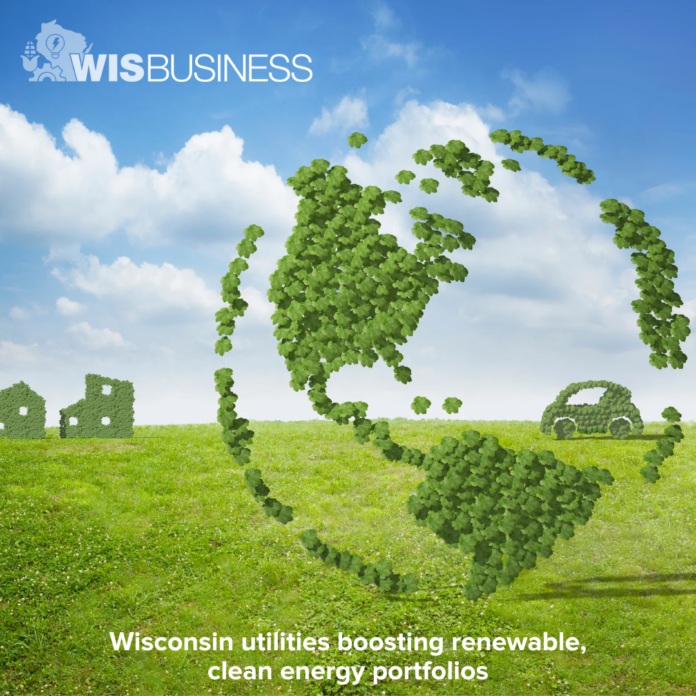Among Wisconsin’s major utilities, Xcel Energy has been leading the pack in the clean energy transition in part because of big contributions from wind and nuclear power.
“They’re way ahead of everybody else,” RENEW Wisconsin Clean Energy Deployment Manager Michael Vickerman said in a recent interview. He referenced the latest state Renewable Portfolio Standard figures as a key measure for tracking utilities’ progress in this transition.
Just over 44% of the electricity Xcel Energy sold to customers in Wisconsin in 2022 came from renewable resources, according to a Public Service Commission memo on RPS results. That’s more than three times as high as its 2022 RPS requirement of 12.89% and substantially higher than any other major utility in the state for the year.
The RPS document covering 2023 won’t be available until early summer, as electric providers have until April 15 to file annual compliance reports for the previous year.
These standards are aimed at increasing energy production from renewable sources. They don’t include nuclear energy, according to the U.S. Department of Energy’s National Renewable Energy Laboratory, as the technology is typically considered a “clean” energy source but not renewable.
Headquartered in the Twin Cities, Xcel Energy does business in Wisconsin through Northern States Power Company. Its upper Midwest system includes parts of five states: Minnesota, North Dakota, South Dakota, Michigan and Wisconsin. Its presence in the state covers parts of western Wisconsin, including Eau Claire, La Crosse, Ashland and other communities.
“So even though they don’t have much in the way of renewable capacity located within the state of Wisconsin, they have quite a lot in Minnesota and other states that serve the entire system,” Vickerman told WisBusiness.com, noting much of that comes from wind power.
The utility says it was among the first U.S. energy companies to have 10,000 megawatts of wind power on its system, having exceeded 11,000 MW in early 2022. By comparison, Wisconsin’s entire wind generation capacity is just over 800 MW from 10 different projects, according to figures from RENEW Wisconsin.
Xcel Energy last month announced a new clean energy plan for the upper Midwest, under which carbon emission reductions are expected to hit 80% by 2030 and could go as high as 88%. The utility says it will extend the use of two carbon-free nuclear plants while adding more wind and solar energy sources and battery storage.
Those two Minnesota nuclear plants — known as Monticello and Prairie Island — collectively supply enough energy to power about 1.5 million homes, making up about 30% of the company’s total electric generation in the upper Midwest region, according to an Xcel Energy spokesperson.
“Our plants provide carbon-free electricity to our customers 24/7, including through extreme weather and periods when renewable sources like solar and wind produce less energy,” the spokesperson said in a statement. “Maintaining these valuable resources is critical to ensuring that we continue to make progress in reducing carbon emissions.”
Until early 2013, two nuclear power plants in Wisconsin provided about 20% of the state’s electricity generation. But since the Kewaunee Nuclear Power Plant shut down in May of that year, the state’s one remaining nuclear facility — the Point Beach Plant — has supplied about 15% of the state’s net annual generation.
In Wisconsin, Xcel owns and operates 19 hydroelectric plants on eight different rivers, two of which are slated for “significant upgrades,” the spokesperson said. The company has completed the first phase of replacing spillway gates at a plant in Chippewa Falls, and has begun a multi-year project focused on the Cedar Falls plant in Menomonie.
Xcel also plans to buy power from the 100-megawatt Apple River Solar project, which is currently being built by National Grid Renewables in western Wisconsin’s Polk County. It’s expected to be one of the largest solar projects in the state, but Xcel says those purchases likely won’t start until 2025.
Ryan Long, president of Xcel Energy-Minnesota, South Dakota and North Dakota, says the new proposal “builds on our already-approved plans to retire all coal plants by 2030” and replace them with renewable energy sources.
While this is a shorter timeframe for eliminating coal than other utilities in the state have committed to, all investor-owned utilities in Wisconsin are expected to phase out the fossil fuel within the next decade or so. Coal made up 36% of the state’s total electricity net generation in 2022, which is down from more than 50% in 2018.
“Our strategy will support renewables with always-available generation resources to ensure the reliability that our customers depend on,” Long said last month in a statement.
Alliant ranks lower on 2022 RPS list, but aggressively pursuing solar in Wisconsin
Wisconsin Power & Light Company, a subsidiary of Madison-based Alliant Energy Corporation, had the second-highest 2022 RPS figure among large electricity providers at 23.65%, easily exceeding its requirement of 9.28%, the PSC memo shows.
Tom Content, executive director of the customer advocacy group Citizens Utility Board, said Alliant Energy has been “the most aggressive” of the state’s large utilities in building solar energy projects.
“We Energies and WPS and MGE have built a bunch of solar too, but Alliant is kind of ahead of them,” he said in an interview.
The company’s renewable percentage is expected to be higher for 2023 due to recent investments in solar, according to Rick Zimmerman, manager of renewable development at Alliant Energy. He noted the utility aims to hit 50% renewable capacity by 2030 as the company pursues the targets of its Clean Energy Blueprint.
“The development of solar energy resources is just one way we’re diversifying our electric generation portfolio and increasing access to clean, reliable, cost-effective energy,” he said in an email, noting Alliant has nearly 900 MW of solar energy capacity currently in service.
But RENEW’s Vickerman said he doesn’t expect Alliant’s RPS figure to change much for 2023. He noted the company “commissioned and energized a lot of solar capacity in the last three months, but those projects didn’t start producing power until December so there will be very little impact on the 2023 report.” He said their impact will start showing up in next year’s report, covering 2024.
“I think the 2024 report will show some fairly significant changes,” Vickerman said. “We have to be patient … It was more than a gigawatt, and a gigawatt is 1,000 megawatts. That’s pretty impressive. So in terms of installed solar capacity in Wisconsin, they are far and away the industry leaders.”
Madison Gas & Electric making steady progress with more solar coming online
Madison Gas & Electric, also based in Madison, more than doubled its 2022 RPS requirement of 7.73%, reaching 18.3% renewable energy for the year. The company is still assembling its data for 2023, and a spokesperson declined to speculate if its RPS figure would increase for last year.
“Our 2024 fuel run approved by the PSCW expects to have 25% of our energy produced by renewable energy resources this year, which is ahead of our goal under our Energy 2030 framework that set a goal of 25% renewable energy by 2025,” the spokesperson said in an email.
The utility has been adding solar and wind energy to its portfolio over the past six years or so, according to its website, and expects to add more than 50 MW from multiple projects that are in the works this year. That includes the Darien Solar Energy Center in Walworth and Rock counties, which is partially owned by MGE.
In a release last month, MGE announced a smaller 6 MW solar array called Tyto Solar is now providing energy to its distribution grid. It’s expected to provide enough electricity to power about 1,400 households per year.
“This project is another step in our journey toward net-zero carbon electricity for all MGE electric customers,” said Jeff Keebler, MGE president, CEO and chair.
MGE last month also filed an application with the PSC to buy a share of the High Noon Solar Energy Center, a 300 MW solar array and 165 MW battery energy storage system planned for Columbia County. If approved, MGE would own 30 MW of solar and 16.5 MW of battery storage, and its share of the project would serve about 9,000 households.
The remainder of that facility, expected to come online in late 2026, would be owned by WEC Energy Group subsidiaries. Once active, the project is expected to produce enough energy for about 90,000 households.
As more resources like this come online, MGE says its electric customers will have 80% lower carbon emissions from electricity use by 2030, while those customers “will have eliminated their carbon footprint” associated with electricity use by 2050. The utility has already reduced carbon emissions nearly 40% from baseline 2005 levels.
WEC Energy Group companies trailing, but major projects coming online soon
Both of the Milwaukee-based company’s subsidiaries — Wisconsin Public Service Corp. and Wisconsin Electric Power Co., or We Energies — trailed other major utilities in the RPS list for 2022.
WPS had a renewable energy percentage of 9.34% for the year, compared to its RPS requirement of 9.74%. And We Energies’ rate of 5.72% was well below the requirement of 8.27% for 2022.
But a WEC Energy Group spokesperson noted the “backward looking” RPS document doesn’t acknowledge the current state of energy generation.
“We are the largest provider of zero carbon generation in Wisconsin, which includes the state’s largest renewable energy facilities that we own and operate,” he said in an email.
The company last year brought online the state’s largest solar project, the Badger Hollow Solar Park, and the Red Barn Wind Park also began operating, he noted. Together, those projects produce enough clean energy to power 140,000 homes. And the utility expects its 250 MW Darien Solar Energy Center and the 200 MW Paris Solar-Battery Park to both begin operating this year — “providing customers across the state even more affordable, reliable and clean energy,” the spokesperson said.
He also said WEC Energy Group is on track to meet its targets of reducing carbon dioxide emissions 60% by the end of 2025 and 80% by the end of 2030, compared to 2005 levels. By the end of 2023, the company had reduced emissions by 54%, he said.
Still, Vickerman was more doubtful that the company could meet its goals.
“As to whether they can meet their clean energy targets, it will take heroic efforts for them to do so,” he said. “But they also have a lot of projects under development right now, so it’s not as though they’re not doing anything about their situation… They got off to a later start, and they have a steeper climb because they serve more customers than, say, Xcel or even [Alliant].”
Along with its clean energy investments, WEC Energy Group is also shutting down its fossil fuel plants as part of its carbon reduction strategy.
“By the end of 2030 we expect to use coal only as a backup fuel and we plan to eliminate coal as an energy source by 2032,” the spokesperson said.
Coal plant retirements a part of clean energy transition
Ultimately, every major Wisconsin utility has established clean energy goals and is advancing their own strategy for achieving them.
Renewable resources provided nearly 11% of Wisconsin’s in-state electricity net generation in 2022, according to figures from the U.S. Energy Information Administration. That figure was 12% for Michigan, 14% for Illinois, 31% for Minnesota and around 66% for Iowa — with nearly all of that coming from wind power.
CUB’s Content notes the Public Service Commission’s latest Strategic Energy Assessment shows the state is projected to go from less than 1% of its energy mix coming from solar to 10% by 2028.
“It’s pretty dramatic,” Content said. “In 2015, it was 0.1% and then in 2020 it was 0.5%. And so the fact that that’s going to go up to 10% is pretty significant. And then wind power is already at 10% … that’s going to go from 10% to 13%.”
The retirement of coal plants is driving this transition, Content noted. Some of the state’s largest coal plants — an older facility in Oak Creek owned by We Energies and another in Portage co-owned by Alliant, WPS and MGE — will both be retired by 2026, he said.
“And after that, we won’t have much left. We’ll have the new Oak Creek plant and then the plant in Wausau,” he said. “But even We Energies is now talking about converting the new coal plant in Oak Creek to run on natural gas instead.”
He said it’s unclear exactly when all investor-owned utilities in the state will be done with coal, but expects that to “definitely” occur within the next 10 years.
Find the 2022 RPS memo here.
–By Alex Moe






